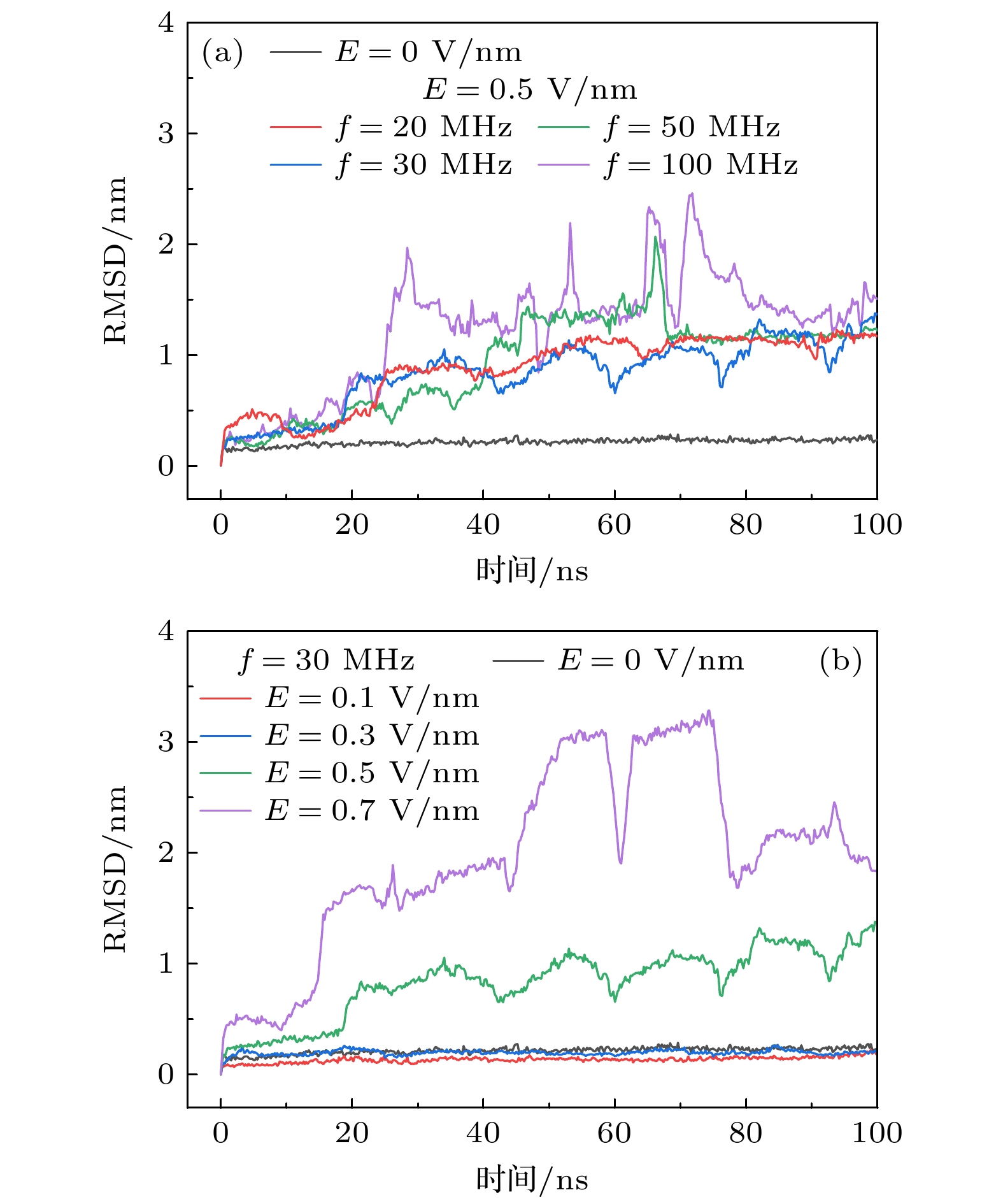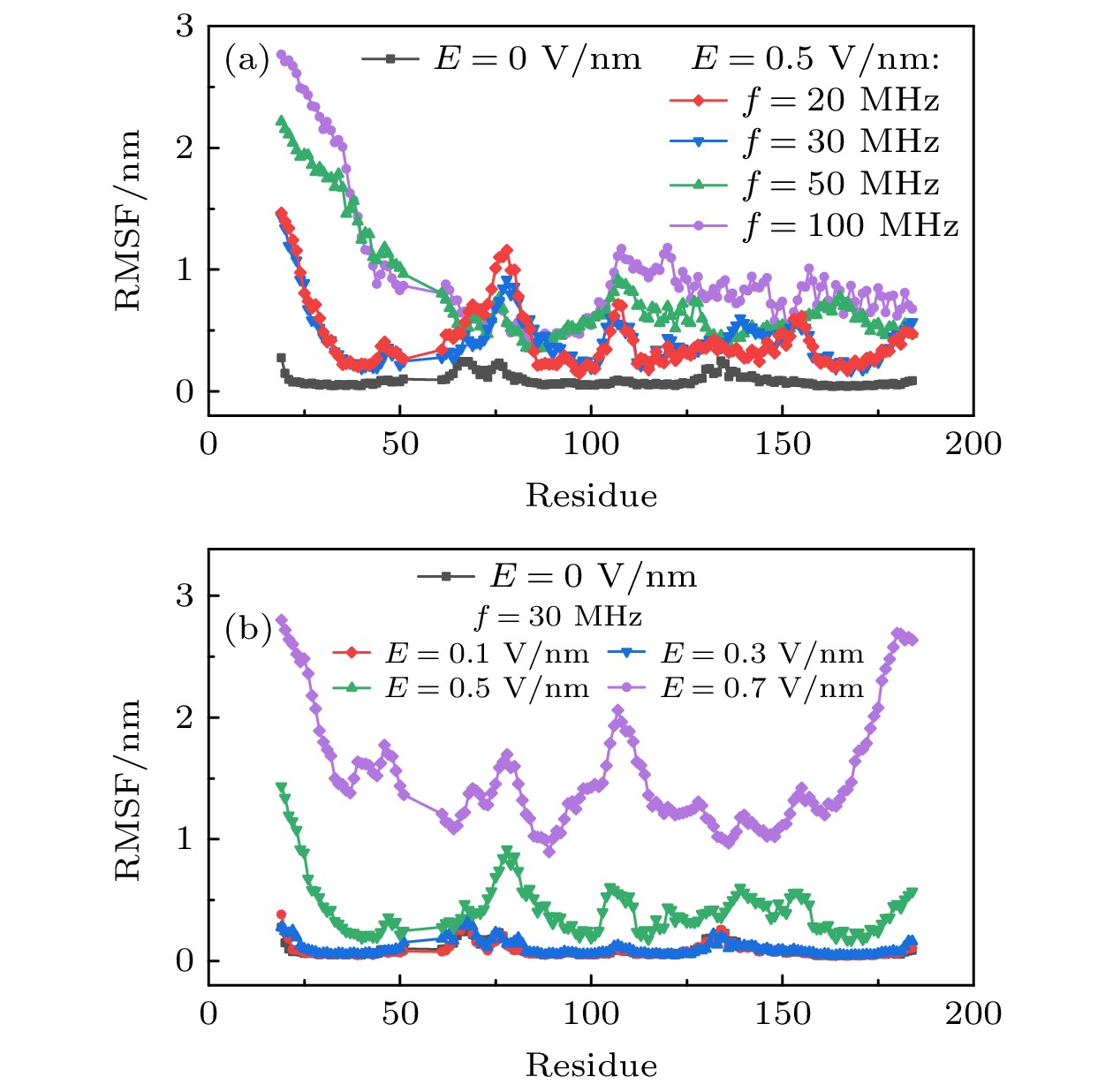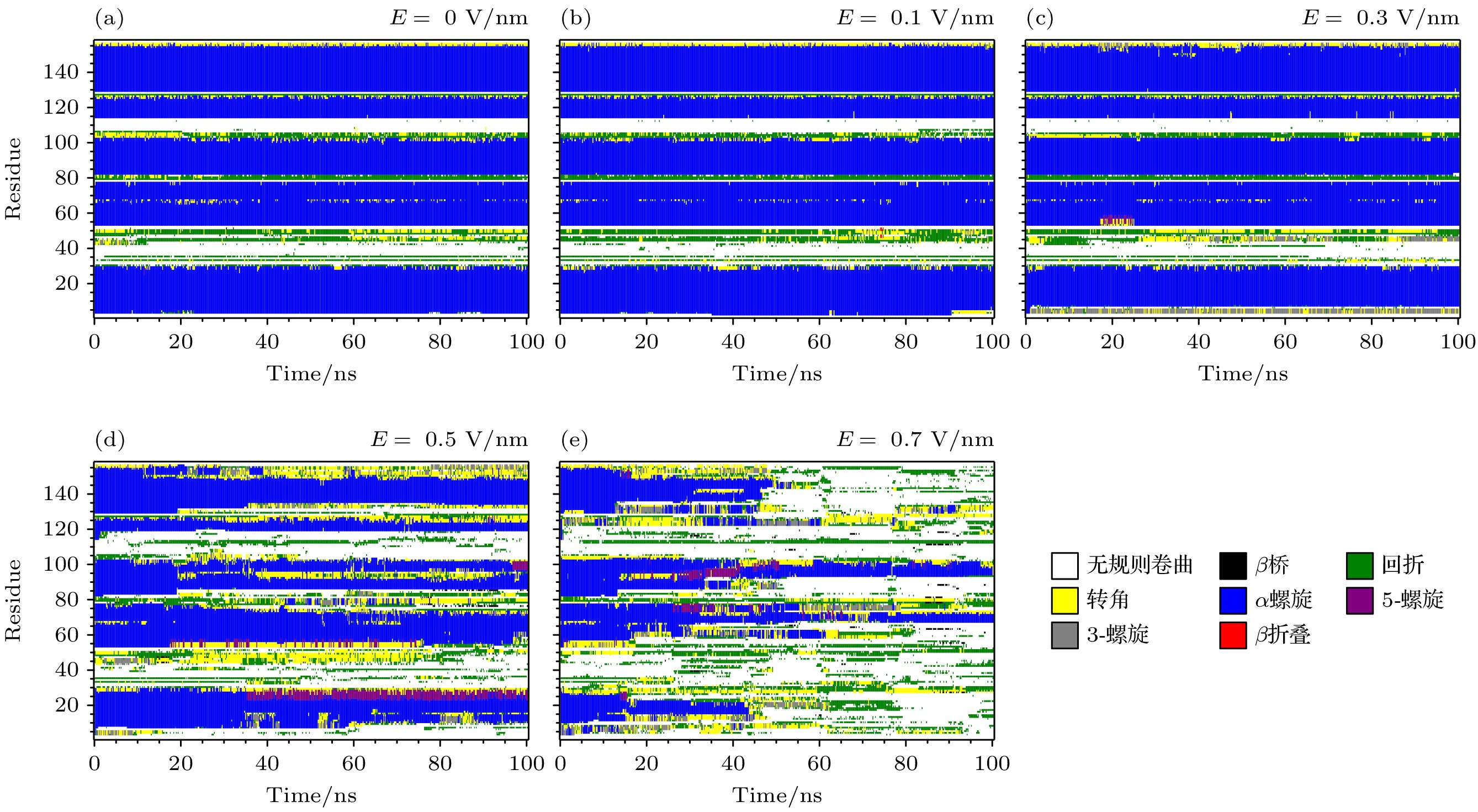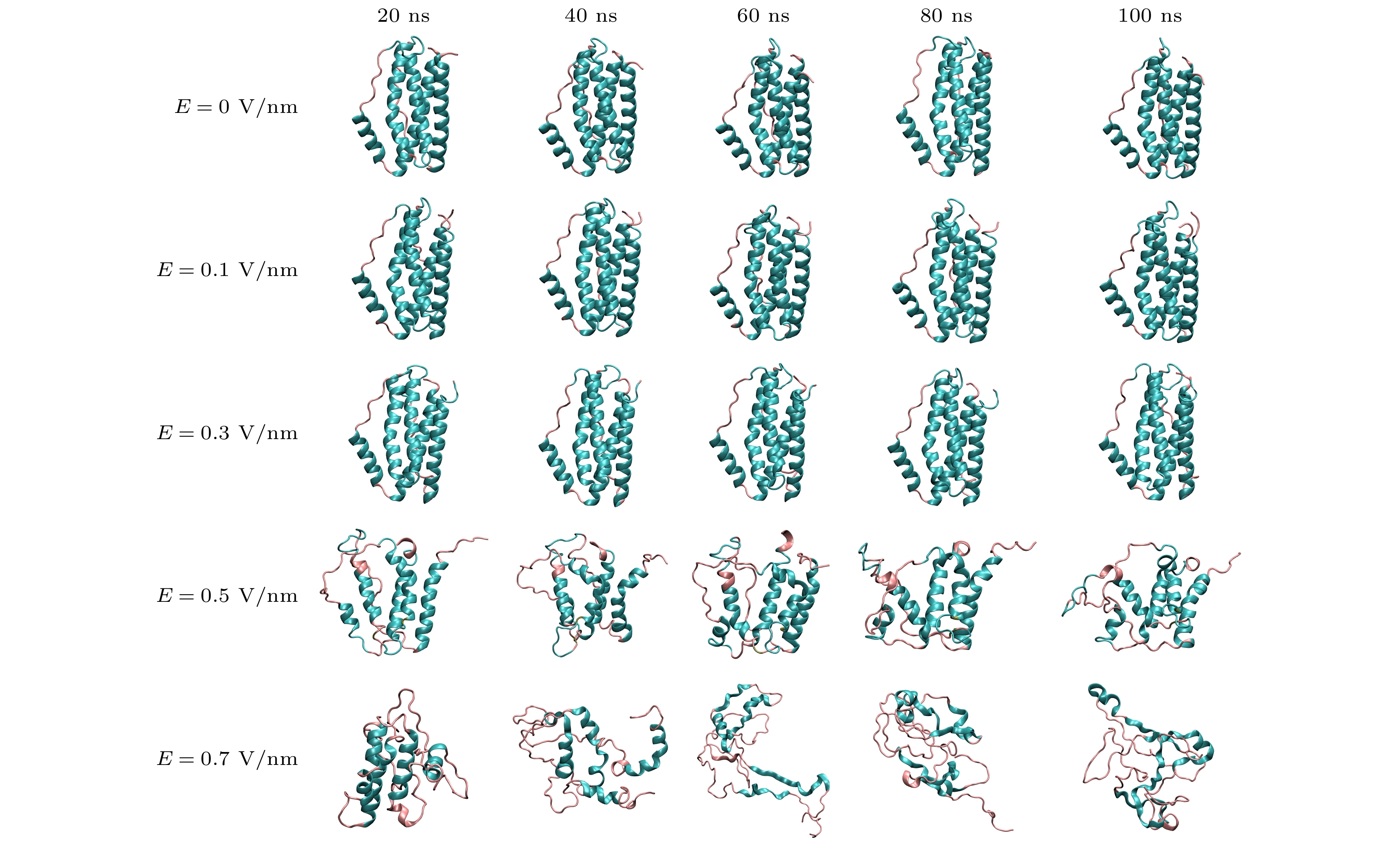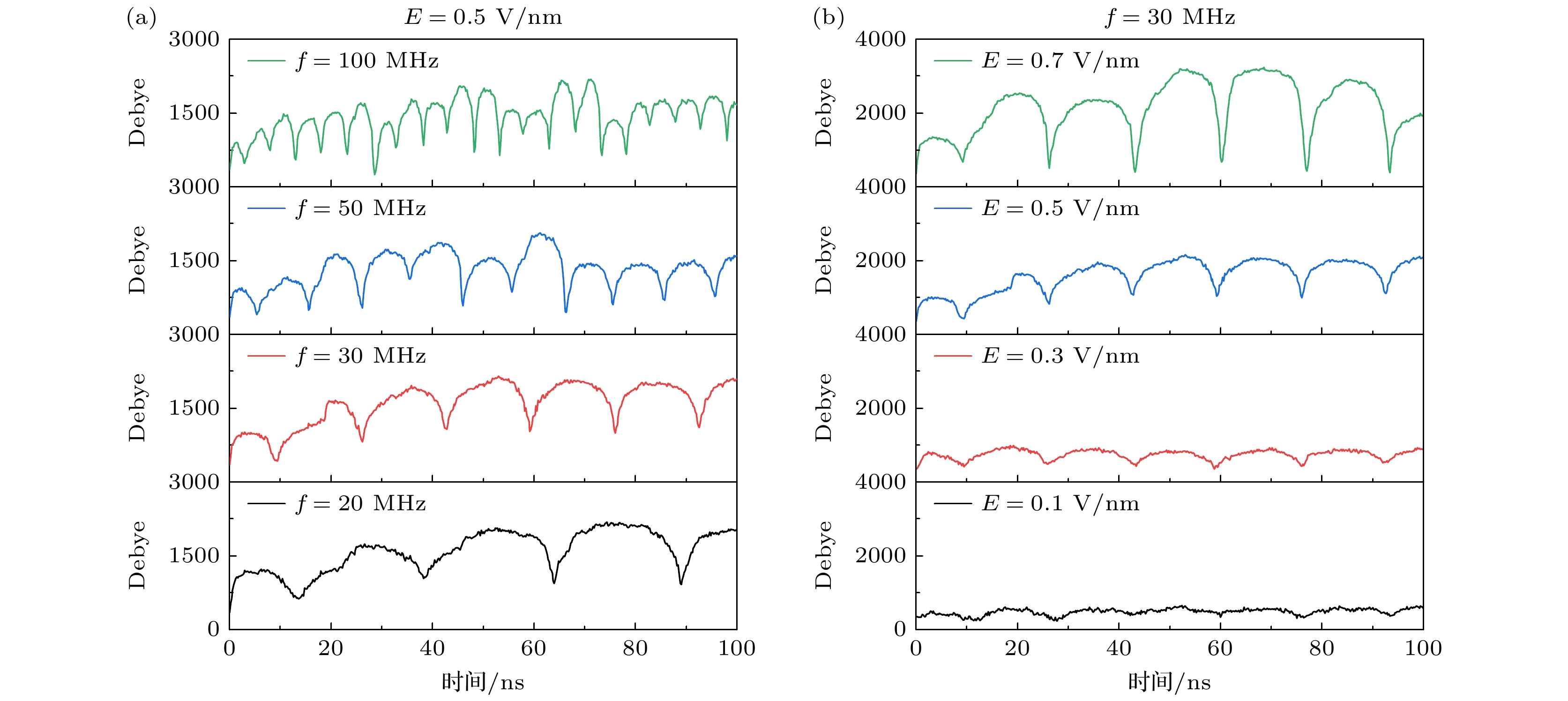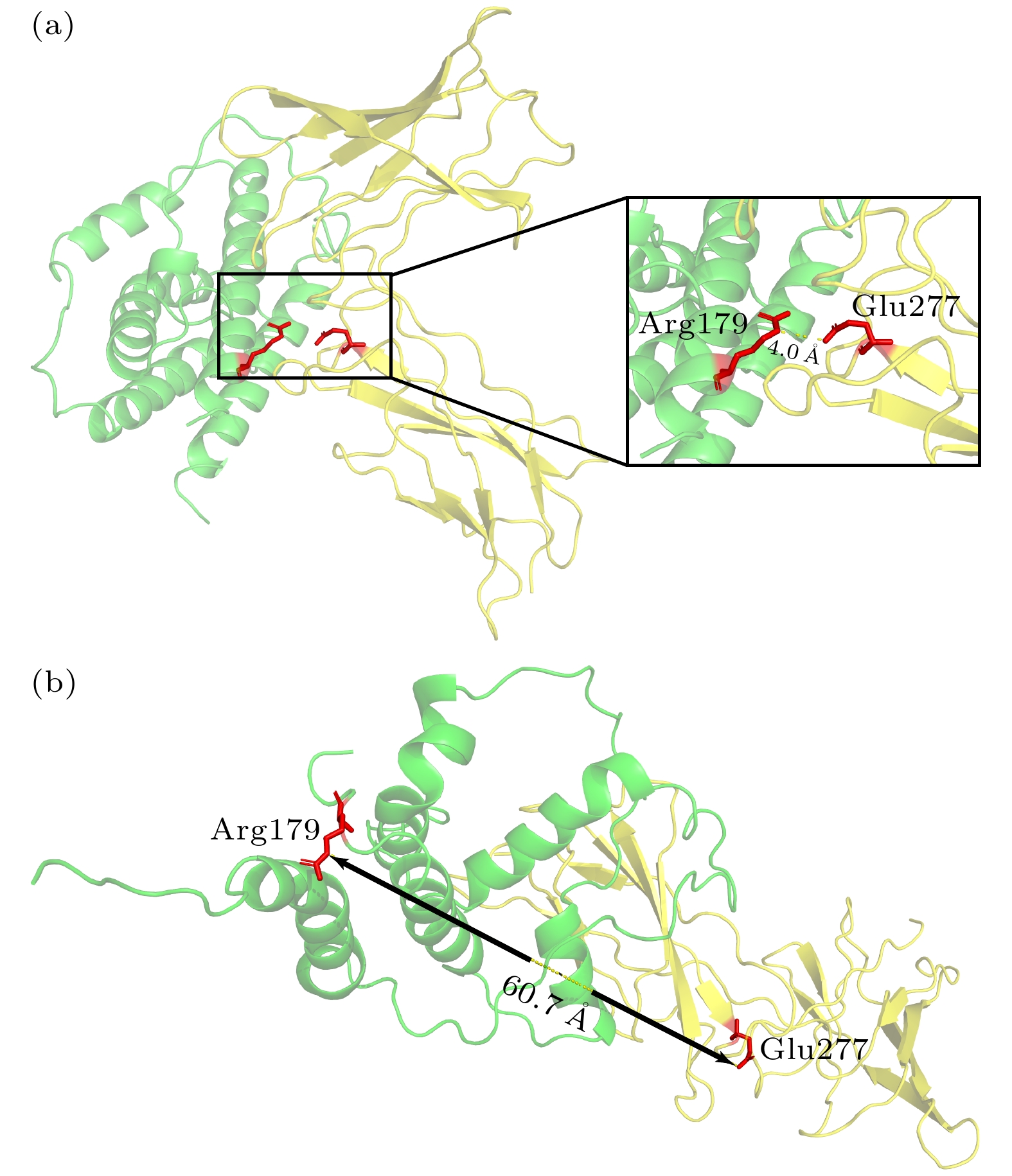-
冷大气压等离子体(cold atmospheric plasma, CAP)由于其具有“选择性”杀伤癌细胞的效果, 而被认为是一种极具潜力的癌症治疗手段. CAP可以通过降低关键炎症因子白细胞介素-6 (interleukin-6, IL-6)的表达, 抑制肿瘤炎症反应并激活免疫系统. 然而CAP携带的强交变电场对IL-6构象及功能的影响仍缺乏了解. 本文采用分子动力学方法, 模拟了不同频率及强度的交变电场对IL-6构象及其与受体对接过程的影响. 结果表明, 当电场频率小于30 MHz且电场强度大于0.5 V/nm时, IL-6的平均偶极矩增大, 长螺旋间维持稳定的盐桥断裂, α螺旋数量减少, 从而影响了IL-6与其受体的结合, 对其发挥正常生物效应机制产生潜在影响. 本文从微观层面上解释了CAP诱导的电场通过IL-6影响相关生物学效应的内部相互作用机制, 并为实际应用CAP治疗肿瘤炎症的参数选取、探索有效的癌症治疗策略提供重要的理论依据.Cold atmospheric plasma (CAP) is considered to be a very promising cancer treatment method due to its “selective” killing effect on cancer cells. The CAP can inhibit tumor inflammatory responses and activate the immune system by reducing the expression of the key inflammatory factor Interleukin-6 (IL-6). However, the influence of the strong alternating electric field induced by CAP on the conformation and function of IL-6 remains unclear. In this study molecular dynamics simulation is used to investigate the effects of alternating electric fields with different frequencies and intensities on the conformation of IL-6. We statistically analyze the root mean square fluctuations, root mean square deviation, secondary structural alterations, and dipole moment changes of IL-6 under different electric field parameters. Furthermore, molecular docking is utilized to assess the influence on the receptor-binding process. The results show that when the electric field frequency is below 30 MHz and the intensity exceeds 0.5 V/nm, the average dipole moment of IL-6 increases, leading to changes in the rigid regions at the C-terminus which maintain structural stability. Specifically, the salt bridges that stabilize the long helices rupture, and the number of α-helices decreases. The docking outcomes reveal that the distance between the key binding residues of the conformationally altered IL-6 and its receptor increases, thereby disrupting the normal binding process and potentially impairing its normal biological functionality. This study explains the internal interaction mechanism of CAP-induced electric fields affecting IL-6-related biological effects at the micro level, and provides important theoretical basis for optimizing parameters in the practical application of CAP in tumor inflammation treatment and the development of effective cancer therapy strategies.
-
Keywords:
- cold atmospheric plasma /
- alternating electric filed /
- interleukin-6 /
- molecular dynamics simulation
[1] Yan D, Sherman J H, Keidar M 2017 Oncotarget 8 15977
 Google Scholar
Google Scholar
[2] Graves D B 2014 Phys. Plasmas 21 080901
 Google Scholar
Google Scholar
[3] Limanowski R, Yan D, Li L, Keidar M 2022 Cancers (Basel) 14 3461
 Google Scholar
Google Scholar
[4] Dubuc A, Monsarrat P, Virard F, et al. 2018 Ther. Adv. Med. Oncol. 10 1
 Google Scholar
Google Scholar
[5] 张浩, 张基珅, 许德晖, 刘定新, 荣命哲 2023 电工技术学报 38 231
 Google Scholar
Google Scholar
Zhang H, Zhang J K, Xu D H, Liu D X, Rong M Z 2023 Trans. China Electrotech. Soc. 38 231
 Google Scholar
Google Scholar
[6] Dai X, Wu J, Lu L, Chen Y 2023 Biomolecules & Therapeutics 31 496
 Google Scholar
Google Scholar
[7] 胡笑钏, 张晓伟, 刘样溪, 周古翔, 吕毅 2022 中国肝胆外科杂志 28 6
 Google Scholar
Google Scholar
Hu X C, Zhang X W, Liu Y X, Zhou G X, Lü Y 2022 Chin. J. Hepatobil. Surg. 28 6
 Google Scholar
Google Scholar
[8] Li Y, Tang T Y, Lee H J, Song K 2021 Int. J. Mol. Sci. 22 3956
 Google Scholar
Google Scholar
[9] Dejonckheere C S, Torres-Crigna A, Layer J P, et al. 2022 Pharmaceutics 14 1767
 Google Scholar
Google Scholar
[10] Schuster M, Seebauer C, Rutkowski R, et al. 2016 J. Craniomaxillofac. Surg. 44 1445
 Google Scholar
Google Scholar
[11] Hirasawa I, Odagiri H, Park G, Sanghavi R, Oshita T, Togi A, Yoshikawa K, Mizutani K, Takeuchi Y, Kobayashi H, Katagiri S, Iwata T, Aoki A 2023 Plos One 18 e0292267
 Google Scholar
Google Scholar
[12] Yusupov M, Van der Paal J, Neyts E C, Bogaerts A 2017 Bba-Gen Subjects 1861 839
 Google Scholar
Google Scholar
[13] Jin X R, Hu X C, Chen J Y, Shan L Q, Hao D J, Zhang R 2024 J. Biomol. Struct. Dyn. DOI: 10.1080/07391102.2024.2329288
[14] Negi M, Kaushik N, Lamichhane P, Jaiswal A, Borkar S B, Patel P, Singh P, Ha Choi E, Kaushik N K 2024 J. Hazard. Mater. 472 134562
 Google Scholar
Google Scholar
[15] Song M H, Tang Y, Cao K M, Qi L, Xie K P 2024 Front. Endocrinol. 15 1408312
 Google Scholar
Google Scholar
[16] Zhao H K, Wu L, Yan G F, Chen Y, Zhou M Y, Wu Y Z, Li Y S 2021 Signal. Transduct. Tar. 6 263
 Google Scholar
Google Scholar
[17] Wolf J, Rose-John S, Garbers C 2014 Cytokine 70 11
 Google Scholar
Google Scholar
[18] Akbari Z, Saadati F, Mahdikia H, Freund E, Abbasvandi F, Shokri B, Zali H, Bekeschus S 2021 Appl. Sci. 11 4527
 Google Scholar
Google Scholar
[19] Fu L, Fung F K, Lo A C, Chan Y K, So K F, Wong I Y, Shih K C, Lai J S 2018 Transl. Vis. Sci. Technol. 7 7
 Google Scholar
Google Scholar
[20] 覃建锋, 宋海旺, 孙宝飞, 吉杨丹, 龙思方, 杨丹 2024 解剖学报 55 260
 Google Scholar
Google Scholar
Tan J F, Song H W, Sun B F, Ji Y D, Long S F, Yang D 2024 Acta Anatom. Sin 55 260
 Google Scholar
Google Scholar
[21] Filipe H A L, Loura L M S 2022 Molecules 27 2105
 Google Scholar
Google Scholar
[22] Wu X, Xu L Y, Li E M, Dong G 2022 Chem. Biol. Drug. Des. 99 789
 Google Scholar
Google Scholar
[23] 孙远昆, 郭良浩, 王凯程, 王少萌, 宫玉彬 2021 物理学报 70 248701
 Google Scholar
Google Scholar
Sun Y K, Guo L H, Wang K C, Wang S M, Gong Y B 2021 Acta Phys. Sin. 70 248701
 Google Scholar
Google Scholar
[24] Zhang Q, Shao D Q, Xu P, Jiang Z T 2022 Polymers-Basel 14 123
 Google Scholar
Google Scholar
[25] Fallah Z, Jamali Y, Rafii-Tabar H 2016 Plos One 11 e0166412
 Google Scholar
Google Scholar
[26] Hu X, Jin X, Xing R, Liu Y, Feng Y, Lyu Y, Zhang R 2023 Results in Physics 51 106621
 Google Scholar
Google Scholar
[27] 周晗, 耿轶钊, 晏世伟 2024 物理学报 73 048701
 Google Scholar
Google Scholar
Zhou H, Geng Y, Yan S 2024 Acta Phys. Sin. 73 048701
 Google Scholar
Google Scholar
[28] Gupta M, Ha K, Agarwal R, Quarles L D, Smith J C 2021 Proteins 89 163
 Google Scholar
Google Scholar
[29] Schillinger O, Panwalkar V, Strodel B, Dingley A J 2017 J. Phys. Chem. B 121 8113
 Google Scholar
Google Scholar
[30] Arisi M, Soglia S, Pisani E G, et al. 2021 Dermatology Ther. 11 855
 Google Scholar
Google Scholar
[31] Uchida G, Ito T, Ikeda J, Suzuki T, Takenaka K, Setsuhara Y 2018 Jpn. J. Appl. Phys. 57 096201
 Google Scholar
Google Scholar
[32] Lin A, Truong B, Patel S, Kaushik N, Choi E H, Fridman G, Fridman A, Miller V 2017 Int. J. Mol. Sci. 18 966
 Google Scholar
Google Scholar
[33] Hu Q, Joshi R P, Schoenbach K H 2005 Phys. Rev. E 72 031902
 Google Scholar
Google Scholar
[34] Pronk S, Páll S, Schulz R, et al. 2013 Bioinformatics 29 845
 Google Scholar
Google Scholar
[35] Huang J, MacKerell A D 2013 J. Comput. Chem. 34 2135
 Google Scholar
Google Scholar
[36] Bussi G, Donadio D, Parrinello M 2007 J. Chem. Phys. 126 014101
 Google Scholar
Google Scholar
[37] Parrinello M, Rahman A 1981 J. Appl. Phys. 52 7182
 Google Scholar
Google Scholar
[38] Cheng T M, Blundell T L, Fernandez-Recio J 2007 Proteins 68 503
 Google Scholar
Google Scholar
[39] Biggin P C, Smith G R, Shrivastava I, Choe S, Sansom M S 2001 Biochim. Biophys. Acta 1510 1
 Google Scholar
Google Scholar
[40] Urabe G, Katagiri T, Katsuki S 2020 Bioelectricity 2 33
 Google Scholar
Google Scholar
[41] 赵伟, 杨瑞金, 张文斌, 华霄, 唐亚丽 2011 食品科学 32 91
 Google Scholar
Google Scholar
Zhao W, Yang R J, Zhang W B, Hua X, Tang Y L 2011 Food Sci. 32 91
 Google Scholar
Google Scholar
[42] Leebeek F W, Kariya K, Schwabe M, Fowlkes D M 1992 J. Biol. Chem. 267 14832
 Google Scholar
Google Scholar
[43] Fontaine V, Savino R, Arcone R, de Wit L, Brakenhoff J P, Content J, Ciliberto G 1993 Eur. J. Biochem. 211 749
 Google Scholar
Google Scholar
[44] Yang Z H, Xiao A, Liu D W, Shi Q, Li Y 2023 Plasma Process Polym. 20 2200242
 Google Scholar
Google Scholar
-
-
[1] Yan D, Sherman J H, Keidar M 2017 Oncotarget 8 15977
 Google Scholar
Google Scholar
[2] Graves D B 2014 Phys. Plasmas 21 080901
 Google Scholar
Google Scholar
[3] Limanowski R, Yan D, Li L, Keidar M 2022 Cancers (Basel) 14 3461
 Google Scholar
Google Scholar
[4] Dubuc A, Monsarrat P, Virard F, et al. 2018 Ther. Adv. Med. Oncol. 10 1
 Google Scholar
Google Scholar
[5] 张浩, 张基珅, 许德晖, 刘定新, 荣命哲 2023 电工技术学报 38 231
 Google Scholar
Google Scholar
Zhang H, Zhang J K, Xu D H, Liu D X, Rong M Z 2023 Trans. China Electrotech. Soc. 38 231
 Google Scholar
Google Scholar
[6] Dai X, Wu J, Lu L, Chen Y 2023 Biomolecules & Therapeutics 31 496
 Google Scholar
Google Scholar
[7] 胡笑钏, 张晓伟, 刘样溪, 周古翔, 吕毅 2022 中国肝胆外科杂志 28 6
 Google Scholar
Google Scholar
Hu X C, Zhang X W, Liu Y X, Zhou G X, Lü Y 2022 Chin. J. Hepatobil. Surg. 28 6
 Google Scholar
Google Scholar
[8] Li Y, Tang T Y, Lee H J, Song K 2021 Int. J. Mol. Sci. 22 3956
 Google Scholar
Google Scholar
[9] Dejonckheere C S, Torres-Crigna A, Layer J P, et al. 2022 Pharmaceutics 14 1767
 Google Scholar
Google Scholar
[10] Schuster M, Seebauer C, Rutkowski R, et al. 2016 J. Craniomaxillofac. Surg. 44 1445
 Google Scholar
Google Scholar
[11] Hirasawa I, Odagiri H, Park G, Sanghavi R, Oshita T, Togi A, Yoshikawa K, Mizutani K, Takeuchi Y, Kobayashi H, Katagiri S, Iwata T, Aoki A 2023 Plos One 18 e0292267
 Google Scholar
Google Scholar
[12] Yusupov M, Van der Paal J, Neyts E C, Bogaerts A 2017 Bba-Gen Subjects 1861 839
 Google Scholar
Google Scholar
[13] Jin X R, Hu X C, Chen J Y, Shan L Q, Hao D J, Zhang R 2024 J. Biomol. Struct. Dyn. DOI: 10.1080/07391102.2024.2329288
[14] Negi M, Kaushik N, Lamichhane P, Jaiswal A, Borkar S B, Patel P, Singh P, Ha Choi E, Kaushik N K 2024 J. Hazard. Mater. 472 134562
 Google Scholar
Google Scholar
[15] Song M H, Tang Y, Cao K M, Qi L, Xie K P 2024 Front. Endocrinol. 15 1408312
 Google Scholar
Google Scholar
[16] Zhao H K, Wu L, Yan G F, Chen Y, Zhou M Y, Wu Y Z, Li Y S 2021 Signal. Transduct. Tar. 6 263
 Google Scholar
Google Scholar
[17] Wolf J, Rose-John S, Garbers C 2014 Cytokine 70 11
 Google Scholar
Google Scholar
[18] Akbari Z, Saadati F, Mahdikia H, Freund E, Abbasvandi F, Shokri B, Zali H, Bekeschus S 2021 Appl. Sci. 11 4527
 Google Scholar
Google Scholar
[19] Fu L, Fung F K, Lo A C, Chan Y K, So K F, Wong I Y, Shih K C, Lai J S 2018 Transl. Vis. Sci. Technol. 7 7
 Google Scholar
Google Scholar
[20] 覃建锋, 宋海旺, 孙宝飞, 吉杨丹, 龙思方, 杨丹 2024 解剖学报 55 260
 Google Scholar
Google Scholar
Tan J F, Song H W, Sun B F, Ji Y D, Long S F, Yang D 2024 Acta Anatom. Sin 55 260
 Google Scholar
Google Scholar
[21] Filipe H A L, Loura L M S 2022 Molecules 27 2105
 Google Scholar
Google Scholar
[22] Wu X, Xu L Y, Li E M, Dong G 2022 Chem. Biol. Drug. Des. 99 789
 Google Scholar
Google Scholar
[23] 孙远昆, 郭良浩, 王凯程, 王少萌, 宫玉彬 2021 物理学报 70 248701
 Google Scholar
Google Scholar
Sun Y K, Guo L H, Wang K C, Wang S M, Gong Y B 2021 Acta Phys. Sin. 70 248701
 Google Scholar
Google Scholar
[24] Zhang Q, Shao D Q, Xu P, Jiang Z T 2022 Polymers-Basel 14 123
 Google Scholar
Google Scholar
[25] Fallah Z, Jamali Y, Rafii-Tabar H 2016 Plos One 11 e0166412
 Google Scholar
Google Scholar
[26] Hu X, Jin X, Xing R, Liu Y, Feng Y, Lyu Y, Zhang R 2023 Results in Physics 51 106621
 Google Scholar
Google Scholar
[27] 周晗, 耿轶钊, 晏世伟 2024 物理学报 73 048701
 Google Scholar
Google Scholar
Zhou H, Geng Y, Yan S 2024 Acta Phys. Sin. 73 048701
 Google Scholar
Google Scholar
[28] Gupta M, Ha K, Agarwal R, Quarles L D, Smith J C 2021 Proteins 89 163
 Google Scholar
Google Scholar
[29] Schillinger O, Panwalkar V, Strodel B, Dingley A J 2017 J. Phys. Chem. B 121 8113
 Google Scholar
Google Scholar
[30] Arisi M, Soglia S, Pisani E G, et al. 2021 Dermatology Ther. 11 855
 Google Scholar
Google Scholar
[31] Uchida G, Ito T, Ikeda J, Suzuki T, Takenaka K, Setsuhara Y 2018 Jpn. J. Appl. Phys. 57 096201
 Google Scholar
Google Scholar
[32] Lin A, Truong B, Patel S, Kaushik N, Choi E H, Fridman G, Fridman A, Miller V 2017 Int. J. Mol. Sci. 18 966
 Google Scholar
Google Scholar
[33] Hu Q, Joshi R P, Schoenbach K H 2005 Phys. Rev. E 72 031902
 Google Scholar
Google Scholar
[34] Pronk S, Páll S, Schulz R, et al. 2013 Bioinformatics 29 845
 Google Scholar
Google Scholar
[35] Huang J, MacKerell A D 2013 J. Comput. Chem. 34 2135
 Google Scholar
Google Scholar
[36] Bussi G, Donadio D, Parrinello M 2007 J. Chem. Phys. 126 014101
 Google Scholar
Google Scholar
[37] Parrinello M, Rahman A 1981 J. Appl. Phys. 52 7182
 Google Scholar
Google Scholar
[38] Cheng T M, Blundell T L, Fernandez-Recio J 2007 Proteins 68 503
 Google Scholar
Google Scholar
[39] Biggin P C, Smith G R, Shrivastava I, Choe S, Sansom M S 2001 Biochim. Biophys. Acta 1510 1
 Google Scholar
Google Scholar
[40] Urabe G, Katagiri T, Katsuki S 2020 Bioelectricity 2 33
 Google Scholar
Google Scholar
[41] 赵伟, 杨瑞金, 张文斌, 华霄, 唐亚丽 2011 食品科学 32 91
 Google Scholar
Google Scholar
Zhao W, Yang R J, Zhang W B, Hua X, Tang Y L 2011 Food Sci. 32 91
 Google Scholar
Google Scholar
[42] Leebeek F W, Kariya K, Schwabe M, Fowlkes D M 1992 J. Biol. Chem. 267 14832
 Google Scholar
Google Scholar
[43] Fontaine V, Savino R, Arcone R, de Wit L, Brakenhoff J P, Content J, Ciliberto G 1993 Eur. J. Biochem. 211 749
 Google Scholar
Google Scholar
[44] Yang Z H, Xiao A, Liu D W, Shi Q, Li Y 2023 Plasma Process Polym. 20 2200242
 Google Scholar
Google Scholar
计量
- 文章访问数: 3199
- PDF下载量: 95
- 被引次数: 0














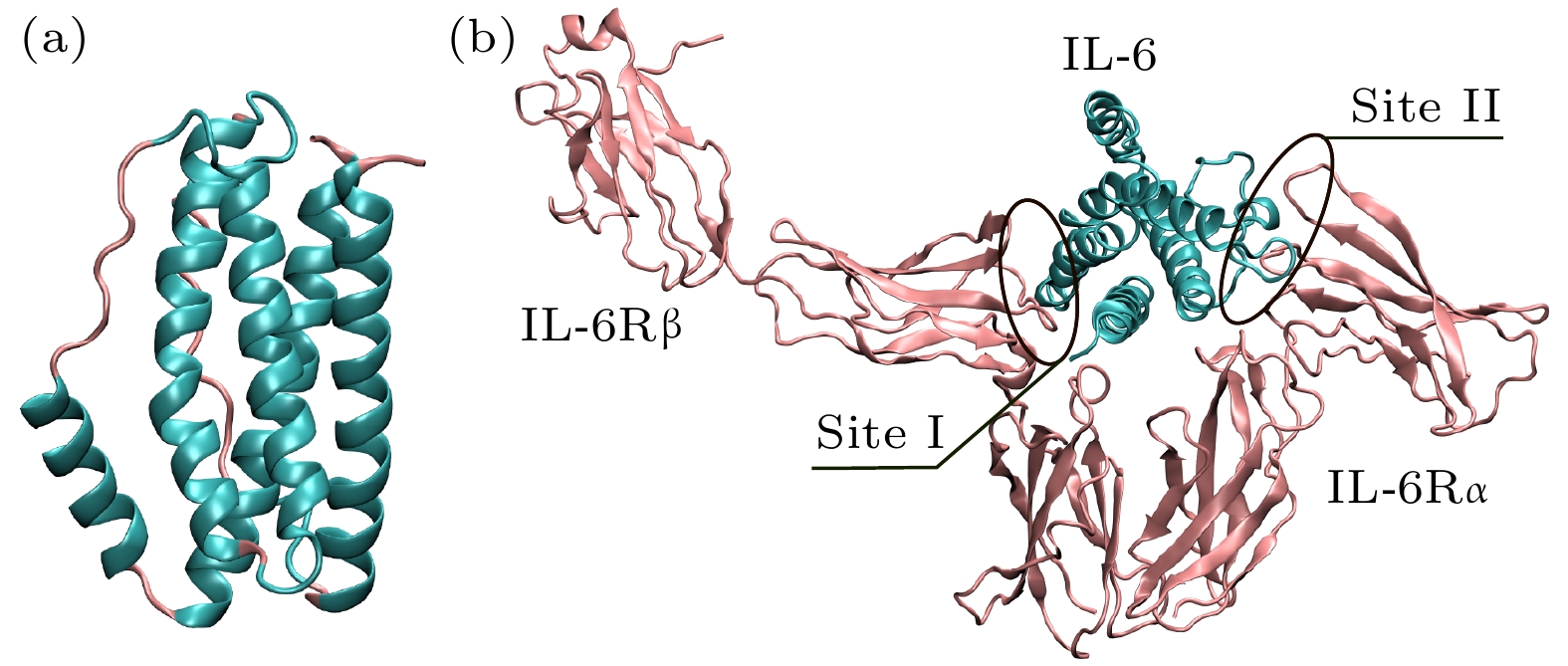
 下载:
下载:
